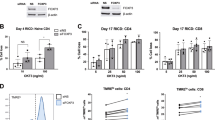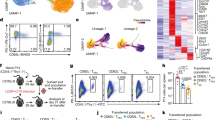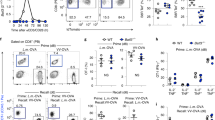Abstract
Foxp3+ regulatory T (Treg) cells are a crucial immunosuppressive population of CD4+ T cells, yet the homeostatic processes and survival programs that maintain the Treg cell pool are poorly understood. Here we report that peripheral Treg cells markedly alter their proliferative and apoptotic rates to rapidly restore numerical deficit through an interleukin 2–dependent and costimulation-dependent process. By contrast, excess Treg cells are removed by attrition, dependent on the Bim-initiated Bak- and Bax-dependent intrinsic apoptotic pathway. The antiapoptotic proteins Bcl-xL and Bcl-2 were dispensable for survival of Treg cells, whereas Mcl-1 was critical for survival of Treg cells, and the loss of this antiapoptotic protein caused fatal autoimmunity. Together, these data define the active processes by which Treg cells maintain homeostasis via critical survival pathways.
This is a preview of subscription content, access via your institution
Access options
Subscribe to this journal
Receive 12 print issues and online access
$209.00 per year
only $17.42 per issue
Buy this article
- Purchase on Springer Link
- Instant access to full article PDF
Prices may be subject to local taxes which are calculated during checkout






Similar content being viewed by others
References
Gavin, M.A. et al. Foxp3-dependent programme of regulatory T-cell differentiation. Nature 445, 771–775 (2007).
Sakaguchi, S. et al. FOXP3+ regulatory T cells in the human immune system. Nat. Rev. Immunol. 10, 490–500 (2010).
Fontenot, J.D. et al. A function for interleukin 2 in Foxp3-expressing regulatory T cells. Nat. Immunol. 6, 1142–1151 (2005).
Chougnet, C.A. et al. A major role for Bim in regulatory T cell homeostasis. J. Immunol. 186, 156–163 (2011).
Siggs, O.M. et al. Opposing functions of the T cell receptor kinase ZAP-70 in immunity and tolerance differentially titrate in response to nucleotide substitutions. Immunity 27, 912–926 (2007).
Tian, L. et al. Foxp3+ regulatory T cells exert asymmetric control over murine helper responses by inducing Th2 cell apoptosis. Blood 118, 1845–1853 (2011).
Miyara, M. et al. Human FoxP3+ regulatory T cells in systemic autoimmune diseases. Autoimmun. Rev. 10, 744–755 (2011).
Lages, C.S. et al. Functional regulatory T cells accumulate in aged hosts and promote chronic infectious disease reactivation. J. Immunol. 181, 1835–1848 (2008).
Raynor, J. et al. Homeostasis and function of regulatory T cells in aging. Curr. Opin. Immunol. 24, 482–487 (2012).
Shimizu, J. et al. Stimulation of CD25(+)CD4(+) regulatory T cells through GITR breaks immunological self-tolerance. Nat. Immunol. 3, 135–142 (2002).
Baba, J. et al. Depletion of radio-resistant regulatory T cells enhances antitumor immunity during recovery from lymphopenia. Blood 120, 2417–2427 (2012).
Youle, R.J. & Strasser, A. The BCL-2 protein family: opposing activities that mediate cell death. Nat. Rev. Mol. Cell Biol. 9, 47–59 (2008).
Strasser, A. The role of BH3-only proteins in the immune system. Nat. Rev. Immunol. 5, 189–200 (2005).
Huang, D.C. & Strasser, A. BH3-Only proteins-essential initiators of apoptotic cell death. Cell 103, 839–842 (2000).
Zheng, L. et al. A novel role of IL-2 in organ-specific autoimmune inflammation beyond regulatory T cell checkpoint: both IL-2 knockout and Fas mutation prolong lifespan of Scurfy mice but by different mechanisms. J. Immunol. 179, 8035–8041 (2007).
Ikeda, T. et al. Dual effects of TRAIL in suppression of autoimmunity: the inhibition of Th1 cells and the promotion of regulatory T cells. J. Immunol. 185, 5259–5267 (2010).
Zhan, Y. et al. Defects in the Bcl-2-regulated apoptotic pathway lead to preferential increase of CD25 low Foxp3+ anergic CD4+ T cells. J. Immunol. 187, 1566–1577 (2011).
Lindsten, T. et al. The combined functions of proapoptotic Bcl-2 family members bak and bax are essential for normal development of multiple tissues. Mol. Cell 6, 1389–1399 (2000).
Wang, X. et al. Preferential control of induced regulatory T cell homeostasis via a Bim/Bcl-2 axis. Cell Death Dis. 3, e270 (2012).
Liu, N. et al. Selective impairment of CD4+CD25+Foxp3+ regulatory T cells by paclitaxel is explained by Bcl-2/Bax mediated apoptosis. Int. Immunopharmacol. 11, 212–219 (2011).
Tischner, D. et al. Defective cell death signalling along the Bcl-2 regulated apoptosis pathway compromises Treg cell development and limits their functionality in mice. J. Autoimmun. 38, 59–69 (2012).
Motoyama, N. et al. Massive cell death of immature hematopoietic cells and neurons in Bcl-x-deficient mice. Science 267, 1506–1510 (1995).
Ma, A. et al. Bclx regulates the survival of double-positive thymocytes. Proc. Natl. Acad. Sci. USA 92, 4763–4767 (1995).
Rubtsov, Y.P. et al. IL-10 produced by regulatory T cells contributes to their suppressor function by limiting inflammation at environmental interfaces. Immunity 28, 546–558 (2008).
Wagner, K.U. et al. Conditional deletion of the Bcl-x gene from erythroid cells results in hemolytic anemia and profound splenomegaly. Development 127, 4949–4958 (2000).
Vikstrom, I. et al. Mcl-1 is essential for germinal center formation and B cell memory. Science 330, 1095–1099 (2010).
Schlenner, S.M. et al. Fate mapping reveals separate origins of T cells and myeloid lineages in the thymus. Immunity 32, 426–436 (2010).
Dzhagalov, I. et al. The anti-apoptotic Bcl-2 family member Mcl-1 promotes T lymphocyte survival at multiple stages. J. Immunol. 181, 521–528 (2008).
Opferman, J.T. et al. Development and maintenance of B and T lymphocytes requires antiapoptotic MCL-1. Nature 426, 671–676 (2003).
Strasser, A. et al. Deciphering the rules of programmed cell death to improve therapy of cancer and other diseases. EMBO J. 30, 3667–3683 (2011).
Bouillet, P. et al. Proapoptotic Bcl-2 relative Bim required for certain apoptotic responses, leukocyte homeostasis, and to preclude autoimmunity. Science 286, 1735–1738 (1999).
Gray, D.H. et al. The BH3-only proteins Bim and Puma cooperate to impose deletional tolerance of organ-specific antigens. Immunity 37, 451–462 (2012).
Boyman, O. et al. Selective stimulation of T cell subsets with antibody-cytokine immune complexes. Science 311, 1924–1927 (2006).
Bautista, J.L. et al. Intraclonal competition limits the fate determination of regulatory T cells in the thymus. Nat. Immunol. 10, 610–617 (2009).
Liston, A. & Rudensky, A.Y. Thymic development and peripheral homeostasis of regulatory T cells. Curr. Opin. Immunol. 19, 176–185 (2007).
Tai, X. et al. Foxp3 is pro-apoptotic and lethal to developing regulatory T cells unless counterbalanced by cytokine survival signals. Immunity (in the press) (2013).
Walker, L.S. CD4+ CD25+ Treg: divide and rule? Immunology 111, 129–137 (2004).
McNeill, A. et al. Partial depletion of CD69low-expressing natural regulatory T cells with the anti-CD25 monoclonal antibody PC61. Scand. J. Immunol. 65, 63–69 (2007).
Suffner, J. et al. Dendritic cells support homeostatic expansion of Foxp3+ regulatory T cells in Foxp3.LuciDTR mice. J. Immunol. 184, 1810–1820 (2010).
Guy, C.S. et al. Distinct TCR signaling pathways drive proliferation and cytokine production in T cells. Nat. Immunol. 14, 262–270 (2013).
Khan, W.N. B cell receptor and BAFF receptor signaling regulation of B cell homeostasis. J. Immunol. 183, 3561–3567 (2009).
Carrette, F. & Surh, C.D. IL-7 signaling and CD127 receptor regulation in the control of T cell homeostasis. Semin. Immunol. 24, 209–217 (2012).
Dummer, W. et al. Autologous regulation of naive T cell homeostasis within the T cell compartment. J. Immunol. 166, 2460–2468 (2001).
Gorelik, L. et al. Normal B cell homeostasis requires B cell activation factor production by radiation-resistant cells. J. Exp. Med. 198, 937–945 (2003).
Wing, K. et al. CTLA-4 control over Foxp3+ regulatory T cell function. Science 322, 271–275 (2008).
Liston, A. et al. Dicer-dependent microRNA pathway safeguards regulatory T cell function. J. Exp. Med. 205, 1993–2004 (2008).
Takeuchi, O. et al. Essential role of BAX,BAK in B cell homeostasis and prevention of autoimmune disease. Proc. Natl. Acad. Sci. USA 102, 11272–11277 (2005).
Raynor, J. et al. IL-15 fosters Treg accrual in aging in the face of declining IL-2 levels. Front. Immunol. (in the press).
Caton, M.L. et al. Notch-RBP-J signaling controls the homeostasis of CD8- dendritic cells in the spleen. J. Exp. Med. 204, 1653–1664 (2007).
Fontenot, J.D. et al. Regulatory T cell lineage specification by the forkhead transcription factor foxp3. Immunity 22, 329–341 (2005).
Liston, A. et al. Differentiation of regulatory Foxp3+ T cells in the thymic cortex. Proc. Natl. Acad. Sci. USA 105, 11903–11908 (2008).
Mombaerts, P. et al. RAG-1-deficient mice have no mature B and T lymphocytes. Cell 68, 869–877 (1992).
Yu, W. et al. Continued RAG expression in late stages of B cell development and no apparent re-induction after immunization. Nature 400, 682–687 (1999).
Srinivas, S. et al. Cre reporter strains produced by targeted insertion of EYFP and ECFP into the ROSA26 locus. BMC Dev. Biol. 1, 4 (2001).
Buch, T. et al. A Cre-inducible diphtheria toxin receptor mediates cell lineage ablation after toxin administration. Nat. Methods 2, 419–426 (2005).
Seibler, J. et al. Rapid generation of inducible mouse mutants. Nucleic Acids Res. 31, e12 (2003).
Kim, J.M. et al. Regulatory T cells prevent catastrophic autoimmunity throughout the lifespan of mice. Nat. Immunol. 8, 191–197 (2007).
Létourneau, S. et al. IL-2/anti-IL-2 antibody complexes show strong biological activity by avoiding interaction with IL-2 receptor alpha subunit CD25. Proc. Natl. Acad. Sci. USA 107, 2171–2176 (2010).
Wee, L.J. et al. CASVM: web server for SVM-based prediction of caspase substrates cleavage sites. Bioinformatics 23, 3241–3243 (2007).
Acknowledgements
We thank P. Fink (University of Washington, Seattle) for providing Rag2–GFP-Tg mice backcrossed to the B6 background, L. Hennighausen (US National Institutes of Health) for providing Bcl2l1fx mice, A. Rudensky (Memorial Sloan-Kettering Cancer Center) for providing Foxp3GFP, Foxp3Cre, Foxp3Thy1.1 and Foxp3DTR mice, G. Kelly and S. Grabow (Walter and Eliza Hall Institute of Medical Research) for CreERT2Mcl1fl and CreERT2Bcl2l1flox mice and Bcl2−/− fetal liver samples, F. Kupresanin, G. Siciliano, G.-F. Dabrowski, K. Humphreys and E. Lanera (Walter and Eliza Hall Institute of Medical Research) for technical assistance, S. Korsmeyer (Harvard Medical School) for BaxflBak1−/− mice, and A. Kallies for critical feedback on the manuscript. This work was supported by grants from the VIB, Marie Curie (TREG to A.L.), European Research Council (IMMUNO to A.L.), Interuniversity Attraction Poles (VII/39 to A.L and P.M.), QSIS (to A.A.F.) and the Australian National Health and Medical Research Council (CDF-1 #637353 to D.H.D.G.). W.P. is funded by Agentschap voor Innovatie door Wetenschap en Technologie. B.C., S.M.S. and S.H.-B. are funded by the Fonds Wetenschappelijk Onderzoek. This work was made possible through Victorian State Government Operational Infrastructure Support and the Australian Government National Health and Medical Research Council Independent Research Institutes Infrastructure Support Scheme.
Author information
Authors and Affiliations
Contributions
W.P., B.C., A.P., S.M.S., J.B., M.J.H., S.S., D.F., S.H.-B., L.-F.L. and J.D. performed the experiments. D.H., A.S., P.B., R.J.L. and C.T.W. provided key reagents. S.M.S., A.A.F., P.M., J.D., D.H.D.G. and A.L. designed the study. W.P., D.H.D.G. and A.L. wrote the manuscript. All authors read and approved the manuscript.
Corresponding authors
Ethics declarations
Competing interests
The spouse of A.L. is an employee of UCB Pharma.
Supplementary information
Supplementary Text and Figures
Supplementary Figures 1–8 (PDF 1384 kb)
Rights and permissions
About this article
Cite this article
Pierson, W., Cauwe, B., Policheni, A. et al. Antiapoptotic Mcl-1 is critical for the survival and niche-filling capacity of Foxp3+ regulatory T cells. Nat Immunol 14, 959–965 (2013). https://doi.org/10.1038/ni.2649
Received:
Accepted:
Published:
Issue Date:
DOI: https://doi.org/10.1038/ni.2649
This article is cited by
-
IL-2 immunotherapy for targeting regulatory T cells in autoimmunity
Genes & Immunity (2023)
-
RIPK1 plays a crucial role in maintaining regulatory T-Cell homeostasis by inhibiting both RIPK3- and FADD-mediated cell death
Cellular & Molecular Immunology (2023)
-
Brain regulatory T cells
Nature Reviews Immunology (2023)
-
CNS Treg cells have alternative functions but run on conventional fuel
Nature Immunology (2022)
-
Retinoic acid signaling acts as a rheostat to balance Treg function
Cellular & Molecular Immunology (2022)



